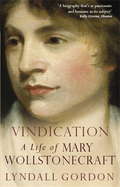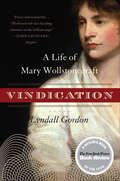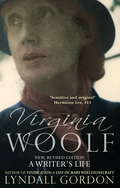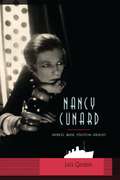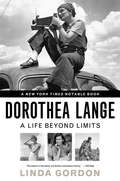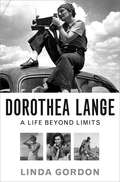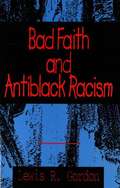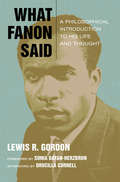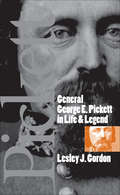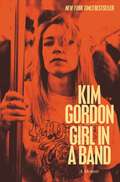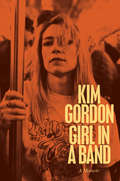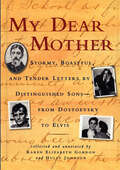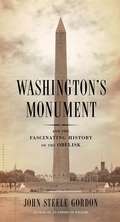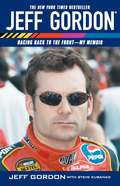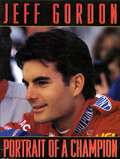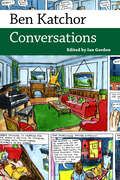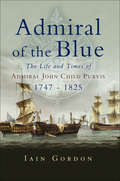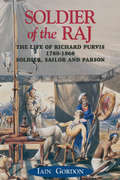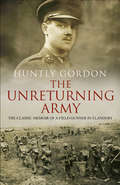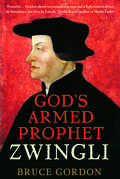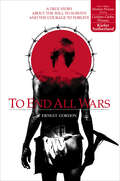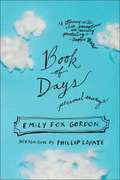- Table View
- List View
Vindication: A Life Of Mary
by Lyndall GordonIn this stunning new biography of the eighteenth-century writer Mary Wollstonecraft, Lyndall Gordon explores the life of a woman often criticised by biographers, historians and feminists alike. Gordon challenges such slanders, and portrays instead the genius of this extraordinary woman. The two-generation approach to her life examines not only Wollstonecraft herself, but also her effect on her daughters and heirs (Mary Shelley, Fanny Imlay, Claire Clairmont and Margaret Mount Cashell), and the ways in which they carried her influence into subsequent generations.Gordon takes stock of Wollstonecraft's life in accord with her own values rather than through the reputation history has given her. The author looks at her important relationships with Gilbert Imlay and William Godwin, and her ideas about issues such as the problems of communication between the sexes and parenthood. Through this brilliant study, Gordon, the author of biographies of Virginia Woolf and Charlotte Brontë among others, successfully reinterprets Mary Wollstonecraft for the twenty-first century.
Vindication: A Life of Mary Wollstonecraft
by Lyndall Gordon“Wonderful, and deeply sobering. . . . Lyndall Gordon relates Wollstonecraft’s story with the same potent mixture of passion and reason her subject personified.”—New York Times Book ReviewThe founder of modern feminism, Mary Wollstonecraft (1759-1797) was the most famous woman in Europe and America in her time. Yet her reputation over the years has suffered—until now. Acclaimed biographer Lyndall Gordon mounts a spirited defense of this brilliant, unconventional woman who held strikingly modern notions of education, single motherhood, family responsibilities, working life, domestic affections, friendships, and sexual relationships.Offering a new interpretation for the 21st century, Gordon paints a vibrant, full portrait of Wollstonecraft, revealing how this remarkable woman’s genius reverberated through the generations, influencing not only her daughter, Mary Shelley, and other heirs, but early political philosophy in England and America as well—including the ideas of John and Abigail Adams.
Virginia Woolf: A Writer's Life
by Lyndall GordonThis prize-winning biography, newly revised, sees Virginia Woolf as she saw herself. The first to set out the private life behind the well-known facts of her public career, A Writer's Life rocks back and forth between memories and art to reveal an explorer of 'the infinite oddity of the human position'. Instead of the doom-and-death often imposed on women of genius, here is the robust walker and seeker for what was fertile in her intimacies, in women's nature, and in resistance to power. This edition brings out her ideas for biography itself: to fall on a life 'like a roll of heavy waters... laying bare the pebbles on the shore of the soul'.
Virginia Woolf: A Writer's Life
by Lyndall GordonThis prize-winning biography, newly revised, sees Virginia Woolf as she saw herself. The first to set out the private life behind the well-known facts of her public career, A Writer's Life rocks back and forth between memories and art to reveal an explorer of 'the infinite oddity of the human position'. Instead of the doom-and-death often imposed on women of genius, here is the robust walker and seeker for what was fertile in her intimacies, in women's nature, and in resistance to power. This edition brings out her ideas for biography itself: to fall on a life 'like a roll of heavy waters... laying bare the pebbles on the shore of the soul'.
Nancy Cunard: Heiress, Muse, Political Idealist
by Lois GordonLois Gordon's absorbing biography tells the story of a writer, activist, and cultural icon who embodied the dazzling energy and tumultuous spirit of her age, and whom William Carlos Williams once called "one of the major phenomena of history."Nancy Cunard (1896-1965) led a life that surpasses Hollywood fantasy. The only child of an English baronet (and heir to the Cunard shipping fortune) and an American beauty, Cunard abandoned the world of a celebrated socialite and Jazz Age icon to pursue a lifelong battle against social injustice as a wartime journalist, humanitarian aid worker, and civil rights champion.Cunard fought fascism on the battlefields of Spain and reported firsthand on the atrocities of the French concentration camps. Intelligent and beautiful, she romanced the great writers of her era, including three Nobel Prize winners, and was the inspiration for characters in the works of Ezra Pound, T. S. Eliot, Aldous Huxley, Pablo Neruda, Samuel Beckett, and Ernest Hemingway, among others. Cunard was also a prolific poet, publisher, and translator and, after falling in love with a black American jazz pianist, became deeply committed to fighting for black rights. She edited the controversial anthology Negro, the first comprehensive study of the achievement and plight of blacks around the world. Her contributors included Langston Hughes, W. E. B. Du Bois, and Zora Neale Hurston, among scores of others.Cunard's personal life was as complex as her public persona. Her involvement with the civil rights movement led her to be ridiculed and rejected by both family and friends. Throughout her life, she was plagued by insecurities and suffered a series of breakdowns, struggling with a sense of guilt over her promiscuous behavior and her ability to survive so much war and tragedy. Yet Cunard's writings also reveal an immense kindness and wit, as well as her renowned, often flamboyant defiance of prejudiced social conventions.Drawing on diaries, correspondence, historical accounts, and the remembrances of others, Lois Gordon revisits the major movements of the first half of the twentieth century through the life of a truly gifted and extraordinary woman. She also returns Nancy Cunard to her rightful place as a major figure in the historical, social, and artistic events of a critical era.
Dorothea Lange: A Life Beyond Limits
by Linda GordonWinner of the 2010 Bancroft Prize and finalist for the 2009 Los Angeles Times Book Prize in Biography: The definitive biography of a heroic chronicler of America's Depression and one of the twentieth century's greatest photographers. We all know Dorothea Lange's iconic photos--the Migrant Mother holding her child, the shoeless children of the Dust Bowl--but now renowned American historian Linda Gordon brings them to three-dimensional life in this groundbreaking exploration of Lange's transformation into a documentarist. Using Lange's life to anchor a moving social history of twentieth-century America, Gordon masterfully re-creates bohemian San Francisco, the Depression, and the Japanese-American internment camps. Accompanied by more than one hundred images--many of them previously unseen and some formerly suppressed--Gordon has written a sparkling, fast-moving story that testifies to her status as one of the most gifted historians of our time. Finalist for the Los Angeles Times Book Prize; a New York Times Notable Book; New Yorker's A Year's Reading; and San Francisco Chronicle Best Book.
Dorothea Lange: A Life Beyond Limits
by Linda GordonA fascinating and well-written portrait of a woman whose photography captured the struggles of depression-era American workers.
Bad Faith and Antiblack Racism
by Lewis R. GordonLewis Gordon presents the first detailed existential phenomenological investigation of antiblack racism as a form of Sartrean bad faith. Bad faith, the attitude in which human beings attempt to evade freedom and responsibility, is treated as a constant possibility of human existence. Antiblack racism, the attitude and practice that involve the construction of black people as fundamentally inferior and subhuman, is examined as an effort to evade the responsibilities of a human and humane world. Gordon argues that the concept of bad faith militates against any human science that is built upon a theory of human nature and as such offers an analysis of antiblack racism that stands as a challenge to our ordinary assumptions of what it means to be human.
What Fanon Said: A Philosophical Introduction to His Life and Thought
by Lewis R. GordonAntiblack racism avows reason is white while emotion, and thus supposedly unreason, is black. Challenging academic adherence to this notion, Lewis R. Gordon offers a portrait of Martinican-turned-Algerian revolutionary psychiatrist and philosopher Frantz Fanon as an exemplar of "livingthought" against forms of reason marked by colonialism and racism. Working from his own translations of the original French texts, Gordon critically engages everything in Fanon from dialectics, ethics, existentialism, and humanism to philosophical anthropology, phenomenology, and political theory aswell as psychiatry and psychoanalysis. Gordon takes into account scholars from across the Global South to address controversies around Fanon's writings on gender and sexuality as well as political violence and the social underclass. In doing so, he confronts the replication of a colonial and racist geography of reason, allowing theoristsfrom the Global South to emerge as interlocutors alongside northern ones in a move that exemplifies what, Gordon argues, Fanon represented in his plea to establish newer and healthier human relationships beyond colonial paradigms.
General George E. Pickett in Life and Legend
by Lesley J. GordonThe man who gave his name to the greatest failed frontal attack in American military history, George E. Pickett is among the most famous Confederate generals of the Civil War. But even today he remains imperfectly understood, a figure shrouded in Lost Cause mythology. In this carefully researched biography, Lesley Gordon moves beyond earlier studies of Pickett. By investigating the central role played by his wife LaSalle in controlling his historical image, Gordon illuminates Pickett's legend as well as his life. After exploring Pickett's prewar life as a professional army officer trained at West Point, battle-tested in Mexico, and seasoned on the western frontier, Gordon traces his return to the South in 1861 to fight for the Confederacy. She examines his experiences during the Civil War, including the famed, but failed, charge at the battle of Gettysburg, and charts the decline in his career that followed. Gordon also looks at Pickett's marriage in 1863 to LaSalle Corbell, like him a child of the Virginia planter elite. Though their life together lasted only twelve years, LaSalle spent her five decades of widowhood writing and speaking about her husband and his military career. Appointing herself Pickett's official biographer, she became a self-proclaimed authority on the war and the Old South. In fact, says Gordon, LaSalle carefully and deliberately created a favorable image of her husband that was at odds with the man she had married."Lesley Gordon's study of George E. Pickett explores the reality of the general's life as well as its romanticized version that survived through the generations. . . . Excellent military history informed by recent scholarship in social history, General George E. Pickett in Life and Legend provides a sophisticated analysis of one of the Civil War's most memorable figures."--Journal of Southern History"Insightful and judicious, sometimes unconventional, and combining a clear narrative thread with a persuasive analysis of available evidence, [this] biography is a convincing assessment of George Pickett's place in Confederate history, an intriguing examination of his--and LaSalle's--character and personality, and a valuable look at the Pickett of legend."--Civil War History"The novelty of this elegantly written book resides in the degree to which Gordon, rather than relying heavily on LaSalle, complaining about her, or both, as previous researchers have done, carefully sifts through her various accounts and separates fact from fiction--and suggests the truths that reside in fiction."--Journal of American HistoryThe man who gave his name to the greatest failed frontal attack in American military history, George E. Pickett is among the most famous Confederate generals of the Civil War. But even today he remains imperfectly understood, a figure shrouded in Lost Cause mythology. In this carefully researched biography, Lesley Gordon moves beyond earlier studies of Pickett. By investigating how Pickett's wife LaSalle, who outlived her husband by five decades, helped control his historical image, Gordon illuminates Pickett's legend as well as his life. -->
Girl in a Band
by Kim GordonKim Gordon, founding member of Sonic Youth, fashion icon, and role model for a generation of women, now tells her story—a memoir of life as an artist, of music, marriage, motherhood, independence, and as one of the first women of rock and roll, written with the lyricism and haunting beauty of Patti Smith's Just Kids.<P><P> Often described as aloof, Kim Gordon opens up as never before in Girl in a Band. Telling the story of her family, growing up in California in the '60s and '70s, her life in visual art, her move to New York City, the men in her life, her marriage, her relationship with her daughter, her music, and her band, Girl in a Band is a rich and beautifully written memoir.<P> Gordon takes us back to the lost New York of the 1980s and '90s that gave rise to Sonic Youth, and the Alternative revolution in popular music. The band helped build a vocabulary of music—paving the way for Nirvana, Hole, Smashing Pumpkins and many other acts. But at its core, Girl in a Band examines the route from girl to woman in uncharted territory, music, art career, what partnership means—and what happens when that identity dissolves.<P> Evocative and edgy, filled with the sights and sounds of a changing world and a transformative life, Girl in a Band is the fascinating chronicle of a remarkable journey and an extraordinary artist.
Girl in a Band
by Kim GordonFor many, Kim Gordon, vocalist, bassist and founding member of Sonic Youth, has always been the epitome of cool. Sonic Youth is one of the most influential and successful bands to emerge from the post-punk New York scene, and their legacy continues to loom large over the landscape of indie rock and American pop culture. Almost as celebrated as the band's defiantly dissonant sound was the marriage between Gordon and her husband, fellow Sonic Youth founder and lead guitarist Thurston Moore. So when Matador Records released a statement in the fall of 2011 announcing that--after twenty-seven years--the two were splitting, fans were devastated. In the middle of a crazy world, they'd seemed so solid. What did this mean? What comes next? What came before?In Girl in a Band, the famously reserved superstar speaks candidly about her past and the future. From her childhood in the sunbaked suburbs of Southern California, growing up with a mentally ill sibling who often sapped her family of emotional capital, to New York's downtown art and music scene in the eighties and nineties and the birth of a band that would pave the way for acts like Nirvana, as well as help inspire the Riot Grrl generation, here is an edgy and evocative portrait of a life in art. Exploring the artists, musicians, and writers who influenced Gordon, and the relationship that defined her life for so long, Girl in a Band is filled with the sights and sounds of a pre-Internet world and is a deeply personal portrait of a woman who has become an icon.
My Dear Mother: Stormy Boastful, and Tender Letters By Distinguished Sons--From Dostoevsky to Elvis
by Karen Elizabeth Gordon Holly JohnsonThis fascinating collection of letters between sons and mothers offers an intimate and unexpected glimpse into the mind and heart of the artist. Here are letters by over fifty writers, painters, and musicians, from boyhood to manhood--including Elvis Presley, Ezra Pound, E. B. White, Paul Cezanne, Henry James, Henri de Toulouse-Lautrec, Richard Wagner, Victor Hugo, Jean Cocteau, Tennessee WIlliams, and Wolfgang Amadeus Mozart.
Washington's Monument: And the Fascinating History of the Obelisk
by John Steele GordonThe colorful story behind one of America's greatest monuments and of the ancient obelisks of Egypt, now scattered around the world. Conceived soon after the American Revolution ended, the great monument to George Washington was not finally completed until almost a century later; the great obelisk was finished in 1884, and remains the tallest stone structure in the world at 555 feet. The story behind its construction is a largely untold and intriguing piece of American history, which acclaimed historian John Steele Gordon relates with verve, connecting it to the colorful saga of the ancient obelisks of Egypt. Nobody knows how many obelisks were crafted in ancient Egypt, or even exactly how they were created and erected since they are made out of hard granite and few known tools of the time were strong enough to work granite. Generally placed in pairs at the entrances to temples, they have in modern times been ingeniously transported around the world to Istanbul, Paris, London, New York, and many other locations. Their stories illuminate that of the Washington Monument, once again open to the public following earthquake damage, and offer a new appreciation for perhaps the most iconic memorial in the country.
Jeff Gordon, Racing Back to the Front: My Memoir
by Jeff Gordon Steve EubanksThe New York Times bestselling autobiography of one of auto racing's greatest drivers -- a pedal-to-the-metal look at the life of a NASCAR champion. Jeff Gordon is the hottest thing on the racetrack today! With his skill, determination, and heartfelt love of competitive driving, he has made the Winner's Circle his second home and has helped transform NASCAR racing into the most watched entertainment in America. Here, Jeff Gordon tells the story of his life behind the wheel -- from his unlikely beginnings on the California junior circuit to his meteoric rise to fame. Noting all the roadblocks he faced along the way, Gordon also gives readers an up-close, high-speed look at what it's really like to climb into the cockpit of a stock car every weekend and offers glimpses into the lives and work of his extraordinary crew. This is Jeff Gordon in front of the pack -- an inspirational, thrilling, and true story of courage and character from one of auto racing's greatest heroes.
Jeff Gordon: Portrait of a Champion
by Jeff Gordon"Go out and work hard and just take it one step at a time."He is a living legend, an athlete whodominates his sport as few otherscan. With his rainbow-colored No.24 Dupont Chevrolet Monte Carlo, JeffGordon has accomplished what noman before him could. In 1997, he wonhis second NASCAR Winston CupSeries championship...the Daytona500...the Coca-Cola 600...the Southern500...The Winston ...the Busch Clash.And he became only the second driverto win NASCAR's toughest prize: TheWinston Million.This stunning photographic portrait captures that extraordinary year--from the opening race at Daytona to theAtlanta Motor Speedway where the title became his-- and offers an intimate glimpse of the man behind the wheel himself. You'll discover what he really thinks about life on and off the track including: his familyNASCAR racingthe people who have helped shape his careerhis spiritualityhis fansbeing a role modelthe Rainbow Warriorsand much more.Honest and straightforward, Jeff shares his triumphs and his failures, what it takes to be the best and what the future may hold. Here is a rare look at an amazing champion on the road to glory."Don't ever quit. Don't ever stop fighting. It's not over 'til it's over."
Ben Katchor: Conversations (Conversations with Comic Artists Series)
by Ian GordonAuthor Michael Chabon described Ben Katchor (b. 1951) as “the creator of the last great American comic strip.” Katchor’s comic strip Julius Knipl, Real Estate Photographer, which began in 1988, brought him to the attention of the readers of alternative weekly newspapers along with a coterie of artists who have gone on to public acclaim. In the mid-1990s, NPR ran audio versions of several Julius Knipl stories, narrated by Katchor and starring Jerry Stiller in the title role.An early contributor to RAW, Katchor also contributed to Forward, the New Yorker, Slate, and weekly newspapers. He edited and published two issues of Picture Story, which featured his own work, with articles and stories by Peter Blegvad, Jerry Moriarty, and Mark Beyer. In addition to being a dramatist, Katchor has been the subject of profiles in the New Yorker, a recipient of a MacArthur “Genius Grant” and a Guggenheim Fellowship, and a fellow at both the American Academy in Berlin and the New York Public Library.Katchor’s work is often described as zany or bizarre, and author Douglas Wolk has characterized his work as “one or two notches too far” beyond an absurdist reality. And yet the work resonates with its audience because, as was the case with Knipl’s journey through the wilderness of a decaying city, absurdity was only what was usefully available; absurdity was the reality. Julius Knipl, Real Estate Photographer presaged the themes of Katchor’s work: a concern with the past, an interest in the intersection of Jewish identity and a secular commercial culture, and the limits and possibilities of urban life.
Admiral of the Blue: The Life and Times of Admiral John Child Purvis (1747–1825)
by Iain GordonAdmiral John Child Purvis was a contemporary naval officer of Nelson, who never disobeyed an order and did his job well. His ability as a fighting commander was proved in a bloody duel between his sloop-of-war and a French corvette during the War of American Independence. As a battleship Captain, he was the first British officer to confront Napoleon Bonaparte, muzzle to muzzle, during the Siege of Toulon. Commanding the Princess Royal and then the London, he was involved in much action in the Mediterranean and served under the legendary Sir John Jervis (later Lord St. Vincent).Later, as a Flag Officer, he rejoined the Mediterranean Fleet first as second-in-command and then as Commander-in-Chief. The culmination of his long and distinguished career at sea was saving the Spanish fleet in Cadiz from capture by the French and preparing the city for siege.
Soldier of the Raj: The Life of Richard Purvis, 1789–1869: Soldier, Sailor and Parson (19th Century Ser.)
by Iain GordonA meticulously researched biography of a young officer in the early part of the 19th Century. The son of an admiral, Richard Purvis went to sea in Nelson's Navy at the age of 11 before being commissioned at the age of 15 into the Bengal Army, part of the great East India Company. He went on to serve 17 years in India before returning to become a country parson.The emphasis of this book is on his Indian military service, with the story told largely through an extensive collection of previously unpublished contemporary letters. These give a unique and intimate insight into the daily lives, difficulties, ethos and humour of young British officers in India during the Napoleonic period. There was, of course, danger and action too and Purvis's role in the Nepal War is described. Patronage was also a feature of a young ambitious man's life during the Georgian period and the workings of this are fascinatingly revealed.
The Unreturning Army
by Huntly GordonIn the centenary year of the Great War, names such as Ypres, the Marne, the Somme, Passchendaele are heavy with meaning as settings for the near-destruction of a generation of men. It is this aura of tragedy that makes Huntly Gordon’s memoir, drawn from his letters written from the Front, such a potent one. He was sensitive, intelligent, unpretentious and, as his account reveals, capable of detached and trenchant judgement. As the summer of 1914 drew to a close, it was difficult for a16 year-old schoolboy to realize that the world for which he had been prepared at Clifton College was itself preparing for war. By 1916, he was commissioned in the Royal Field Artillery. By June 1917, he was at the Ypres Salient getting his ‘baptism’ at Hell Fire Corner in an intensive artillery duel that formed the prologue to Passchendaele itself. Early in 1918, his battery would fight a series of rearguard actions near Baupaume that would help turn the tide of the massive German Spring offensive. Huntly Gordon has given us an enduring and classic memoir: a poignant and extraordinarily human account of history as it happened.
Are You Happy?
by Gordon Emily FoxEmily Fox Gordon was a fatty, an academic failure, a schoolyard pariah, and a disappointment to her highly educated parents. And yet her early life was, as she puts it, "a succession of moments of radiant apprehension. " Growing up in a Massachusetts college town in the fifties, she cultivated the writer's lifelong habit of translating experience into words. As she grew older, she became aware of her mother's long withdrawal into alcoholic depression. For Emily this was a new kind of observation, made from the outside-one that changed her childish view of the world, and ended her childhood.
Zwingli: God's Armed Prophet
by F. Bruce GordonA major new biography of Huldrych Zwingli—the warrior preacher who shaped the early Reformation Huldrych Zwingli (1484–1531) was the most significant early reformer after Martin Luther. As the architect of the Reformation in Switzerland, he created the Reformed tradition later inherited by John Calvin. His movement ultimately became a global religion. A visionary of a new society, Zwingli was also a divisive and fiercely radical figure. Bruce Gordon presents a fresh interpretation of the early Reformation and the key role played by Zwingli. A charismatic preacher and politician, Zwingli transformed church and society in Zurich and inspired supporters throughout Europe. Yet, Gordon shows, he was seen as an agitator and heretic by many and his bellicose, unyielding efforts to realize his vision would prove his undoing. Unable to control the movement he had launched, Zwingli died on the battlefield fighting his Catholic opponents.
To End All Wars: A True Story About the Will to Survive and the Courage to Forgive
by Ernest GordonNow a major motion picture starring Robert Carlyle and Kiefer Sutherland "Waking from a dream, I suddenly realized where I was: in the Death House--in a prison camp by the River Kwai. I was a prisoner of war, lying among the dead, waiting for the bodies to be carried away so that I might have more room."When Ernest Gordon was twenty-four he was captured by the Japanese and forced, with other British prisoners, to build the notorious "Railroad of Death," where nearly 16,000 prisoners of war gave their life. Faced with the appalling conditions of the prisoners' camp and the brutality of the captors, he survived to become an inspiring example of the triumph of the human spirit against all odds.To End All Wars is Ernest Gordon's gripping true story behind both the Academy Award-winning film The Bridge on the River Kwai, starring Alec Guinness, and the new film To End All Wars, directed by David Cunningham.
Book of Days: Personal Essays
by Emily Fox GordonThe sexual politics of a faculty wives dinner. The psychological gamesmanship of an inappropriate therapist. The emotional minefield of an extended family wedding . . . Whatever the subject, Emily Fox Gordon&’s disarmingly personal essays are an art form unto themselves—reflecting and revealing, like mirrors in a maze, the seemingly endless ways a woman can lose herself in the modern world. With piercing humor and merciless precision, Gordon zigzags her way through &“the unevolved paradise&” of academia, with its dying breeds of bohemians, adulterers, and flirts, then stumbles through the perils and pleasures of psychotherapy, hoping to find a narrative for her life. Along the way, she encounters textbook feminists, partying philosophers, perfectionist moms, and an unlikely kinship with Kafka—in a brilliant collection of essays that challenge our sacred institutions, defy our expectations, and define our lives.
